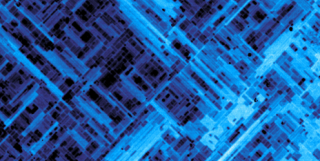Jun 8 2015
Scientists at ETH Zurich have been conducting intense studies on the domain boundaries in multiferroic materials. They have been able to visualize the inner workings of the material, and also modify their internal order. This discovery holds promise for potential development of electronics applications.
 Strontium manganite is a multiferroic, here present in a thin crystal layer. This magnified image shows the individual domains, which are only about 100 nanometres wide. (Image: Becher C et al., Nature Nanotechnology 2015)
Strontium manganite is a multiferroic, here present in a thin crystal layer. This magnified image shows the individual domains, which are only about 100 nanometres wide. (Image: Becher C et al., Nature Nanotechnology 2015)
When compared to domestic magnets that are available commercially, most other magnetic materials possess a more complicated structure. Apart a north and south pole, they have numerous sectors, where the magnetic axis of each of these sectors point in a different direction. These sectors are often in the nanometer scale, and are called as domains.
Manfred Fiebig, Professor for Multifunctional Ferroics at ETH Zurich, has been conducting research on the boundaries or walls between neighboring domains, for the past couple of years. “The inner workings of a material and its domains are one area of interest,” says Fiebig. “However, fascinating things also take place at the boundaries of these domains.”
Fiebig has focused on oxide materials possessing multiferroic properties in this study. These oxide materials are crystalline materials having magnetic north and south poles, and also an electric charge that provides positive and negative electrical poles. This is called as electrical order.
“That fact that magnetic and electrical ordering occur alongside one another in multiferroic materials means that cross couplings are also possible; for example, the magnetic state can be changed using an electrical voltage,” explains Fiebig. These unique properties have induced significant interest among scientists.
Fiebig has published two articles about domain boundaries in certain multiferroic materials, along with other researchers. They have demonstrated that the domain walls had electrical conductivity that was different from other parts of the material. The domain walls were found to suppress the electric current flow in strontium manganite material.
“A material with non-conductive walls in a conductive environment could be very useful in the field of electronics,” says Fiebig. This holds promise for developing electronic components, where their nanoscale domains function as tiny capacitors that could be charged in a separate manner.
“This could be used to create a new charge-based storage medium,” says Fiebig. The charge in a domain could be altered with just a voltage pulse, without the requirement of a current flow. When compared to existing storage mediums, this would demonstrate better energy efficiency. Furthermore, storage media of much smaller size can be built as waste heat that requires dissipation would not be produced.
This study was a collaboration between Fiebig’s research group, ETH professor Nicola Spaldin’s research group and researchers from the University of Zaragoza. The theoretical explanation for the non-conductive domain walls in strontium manganite was provided by Spaldin and her colleagues.
Crystalline materials do not possess a perfect structure, and hence at specific points in its crystal lattice, individual oxygen atoms would be missing. These ‘oxygen vacancies’ seem to prefer to accumulate at these ‘oxygen vacancies’, where current flow is blocked by them.
Fiebig’s group collaborated with scientists from Japan on studies of terbium manganite, which is another multiferroic material. They demonstrated that under specific conditions, electrical fields could be used to shift the domain boundaries.
“This is an advantage over conventional semiconductor materials, which have a mature, fixed structure,” says Fiebig. Additionally, they determined that without modifying boundary position, they could change the domain boundary conductivity and the domain magnetization.
A technique that shows the boundaries and the domains is required for these studies. The second harmonic generation optical method is the only method that would enable visibility of these places. In this method, a highly intense, pulsed laser beam of a specific color is used to irradiate the material, which responds by emitting light with a different color.
This would provide information about the material’s electrical and magnetic structure. Fiebig has played a major role in development of the second harmonic generation optical method for studying the material’s internal order.
These studies have enabled the possibility of viewing the domain walls and also selectively shifting them or modifying the conductance in multiferroic materials. This would enable further technical developments. Fiebig states that these findings could be applied in future sensors, complex electronic components and data storage applications.
“If you can alter the conductance in a material, you have got a switch – in our case, a switch that you can control without moving anything mechanically and which is therefore not subject to material fatigue,” says Fiebig.
Presently, an electric field could be used to alter the magnetic state. However, in the future, intense light pulses could be used for switching the state, which would enable visualization and modification of the internal structure.